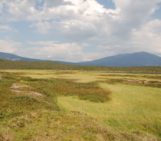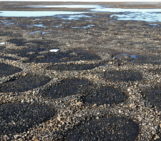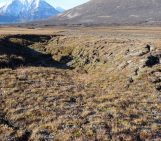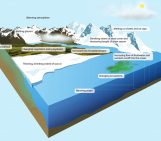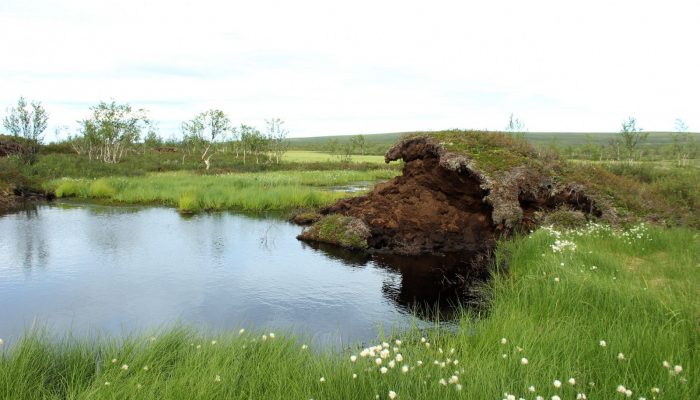
Some of the most remarkable, marginal features of permafrost – palsas – are degrading and disappearing metre by metre from North European peatlands, and are driven close to extinction by the climate change.
What are these permafrost features?
A palsa is a peat mound with an icy core, which stays frozen throughout summer due to the insulating property of dry peat. These mounds can rise up to 10 metres above the surface of surrounding mire (wet terrain dominated by peat-forming vegetation), and they may occur as just a single palsa, group of palsas or as an extensive, but not very high (ca. 1 to 2 m) peat “platform”. The occurrence of palsas is limited by such factors as: low mean annual air temperature (< 0 °C), low annual precipitation (< 500 mm) and at least 40–50 cm thickness of peat layer, which is needed to sufficiently insulate the core during summer (Seppälä, 2011).
The established theory on palsas formation (Seppälä, 2011) is the following:
-
The formation of a palsa begins when a part of mire freezes deeper in a windblown area with thinner snow cover, which normally protects the ground below from freezing temperatures.
-
If the frozen peat doesn’t melt completely during summer, an ice lens forms inside the peat layer resulting in uplifting of the mire surface in this area.
-
In the following winters, the snow is even more likely to be windblown from the mound, which again fosters deeper penetration of frost and formation of new ice lenses.
-
As soon as a part of mire rises above the water level, the vegetation starts to change and the peat dries out, which contributes to the survival of the ice core during summers.
Breaking of the surface and erosion is a natural “step” for mature palsas, when the permafrost has reached the mineral ground below the peat. The melting of a palsa is a form of thermokarst, i.e. thawing of ice-rich permafrost (see this post for more details about thermokarst).

Block-erosion of peat on ridge-type palsa in Nierivuoma mire in Enontekiö, Finland [Credit: Mariana Verdonen].
Palsa, peat hummock or permafrost plateau?
The terminology used when speaking about these permafrost mounds varies, usually according to the continent the research was conducted on or the background of the authors. The term “palsa” comes from Lapland, and was used by Sami and northern Finns to refer to “hummock rising out of a bog with a core of ice” (Seppälä, 1972). In Fennoscandia, this term is used commonly for all main types: ridges, mounds and plateau palsas, whereas in North America the more common terms are either ‘peat or permafrost plateau’ or ‘wooded palsa’ depending on the shape and vegetation cover of the feature (Luoto et al, 2004).
Degrading permafrost of Fennoscandia
More often than not, one may encounter a desolate sight in North European palsa mires: most of the permafrost mounds are degrading by block erosion and/or melting away as a result of thawing of their frozen core. The vegetation that once was growing on hummocks above the wet mire surface, is now dead black in shallow thermokarst ponds surrounding palsas here and there. Although, in some places the conditions may still be favorable for new palsas to form, the general picture is devastating. Palsas are disappearing in most of their area of existence, and it is happening fast.

Thawing palsas of Nierivuoma captured from drone in July 2018. This peatland sprawls across ~7 km2 and is the largest palsa mire in Finland [Credit: Timo Kumpula].
Why should we care?
As climatic change is likely to increase winter and summer precipitation, and is already notable in rising mean annual air temperatures, palsas are predicted to disappear in Fennoscandia almost completely by the end of the 21st century (Fronzek et al, 2010).
It is noteworthy, that the palsa mire is the only mire and bog habitat that is listed as “critically endangered” in the 2016 European Red List of Habitats. While some other cold climate ecosystems may shift to higher latitudes and altitudes, palsa mires seem to be restricted from developing in higher areas, especially because of the required peat layer thickness (Luoto et al, 2004).
If just the loss of this diverse ecosystem type is not alarming by itself, there are couple of issues that I want to highlight:
-
Thawing of the perennially frozen peat changes the carbon fluxes of palsa mires as carbon previously trapped by permafrost becomes available for decay. As the area of dry peat surface decreases, more carbon is released into the atmosphere in the form of more effective greenhouse gas methane (CH4) instead of carbon dioxide (CO2). Recently, also the effects of permafrost thaw on the emissions of nitrous oxide (N2O), which is a strong greenhouse gas, have gained more attention (Marushchak et al, 2011).
-
The heterogeneity formed by variety of mire surfaces, thermokartst ponds and dry palsa mounds creates favorable conditions for species richness in these subarctic environments. In particular, the number and density of bird species seems to be high in the zone of palsa mires compared to more southern mire zones in Fennoscandia, even though no species have been reported to be exclusive to palsa mires (Luoto et al, 2004). This relationship, as well as overall significance of palsa mires for biodiversity is still poorly understood, however.
References
- Fronzek, S, TR Carter, J Raeisaenen, L Ruokolainen, and M Luoto. 2010. “Applying probabilistic projections of climate change with impact models: a case study for sub-arctic palsa mires in Fennoscandia.” Climatic Change 99 (3–4): 515–534. doi: 10.1007/s10584-009-9679-y.
- Luoto, M, RK Heikkinen, and TR Carter. 2004. “Loss of palsa mires in Europe and biological consequences.” Environmental Conservation 31 (1): 30–37. doi: 10.1017/S0376892904001018.
- Marushchak, ME, A Pitkämäki, H Koponen, C Biasi, M Seppälä, and PJ Martikainen. 2011. “Hot spots for nitrous oxide emissions found in different types of permafrost peatlands.” Global Change Biology 17 (8): 2601–2614. doi: 10.1111/j.1365-2486.2011.02442.x
- Seppälä, M. 1972. The term “palsa”. Zeitschrift für Geomorphologie 16 (4): 463
- Seppälä, M. 2011. “Synthesis of studies of palsa formation underlining the importance of local environmental and physical characteristics.” Quaternary Research 75: 366–370. doi: 10.1016/j.yqres.2010.09.007
- Image of the Week – Biscuits in the Permafrost
- Image of the Week – When the dirty cryosphere destabilizes!
Edited by Clara Burgard
 Mariana Verdonen is an Early Stage Researcher at the University of Eastern Finland. She focuses on optical, multi-temporal and multiscale remote sensing of environmental changes in Arctic and Subarctic areas. Mariana’s scientific interests are generally in geomorphology, permafrost-landscape dynamics and remote sensing of the Cryosphere. She tweets as @MarianaVerdonen. Contact Email: mariana.verdonen@uef.fi
Mariana Verdonen is an Early Stage Researcher at the University of Eastern Finland. She focuses on optical, multi-temporal and multiscale remote sensing of environmental changes in Arctic and Subarctic areas. Mariana’s scientific interests are generally in geomorphology, permafrost-landscape dynamics and remote sensing of the Cryosphere. She tweets as @MarianaVerdonen. Contact Email: mariana.verdonen@uef.fi

